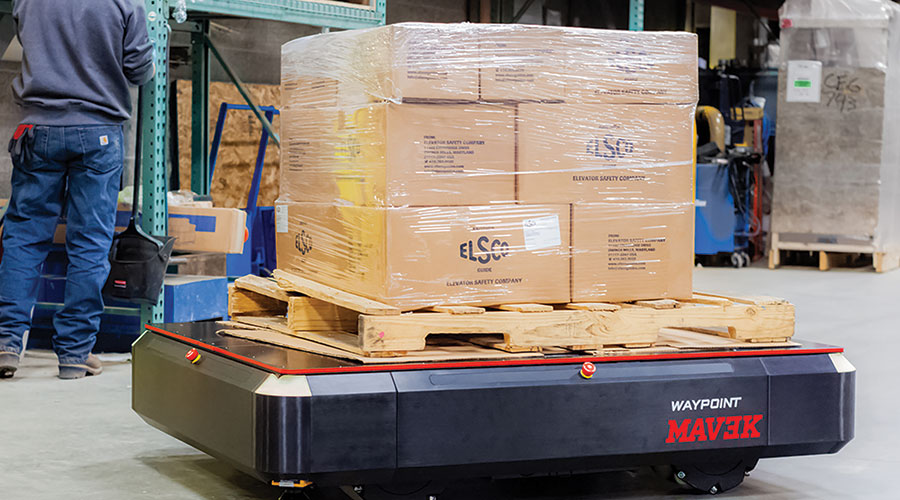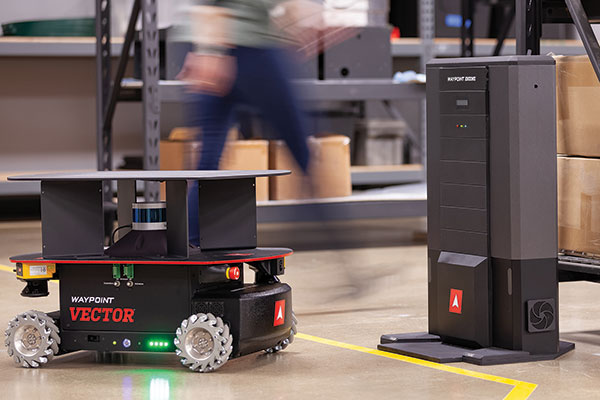Extraordinary times—and a need for proven measures—may be what propels robotics to the next level in warehouse and distribution center (DC) operations.
Not that robotics has been slow to catch on in warehousing. According to analyst firm ABI Research, the global mobile robotics market will reach $23 billion this year. In a 2020 survey by Peerless Research as part of our annual “Industry Outlook” study, 9% surveyed told us they were already using robotics, and 19% were considering them.
But can robotics for intralogistics keep growing quickly, given the disruption from the COVID-19 pandemic? Unemployment has skyrocketed. Some manufacturers temporarily had to shut down sites, and many companies have tightened their budgets, at least in the short term.
At the same time, e-commerce has spiked, especially in sectors like grocery. And while it may be too early to tally the impacts of the pandemic on robotics, in the long term, the technology’s ability to increase productivity with minimal added labor bodes well for the technology, says Rian Whitton, a senior analyst at ABI.
“From what we’re seeing, there has been a huge increase in demand for e-commerce during the pandemic,” says Whitton. “And the greater the percentage of retail that shifts to online, the more heavily automated these warehouses and other facilities involved with fulfillment will need to become, which should accelerate the market for mobile robotics.”
Robotics spans autonomous mobile robots (AMRs) that transport goods or assist workers with picking, as well as fixed robotic arms that can identify and pick goods. Some workflows may combine the two, with AMRs transporting bins to robotic arms. Some vendors, such as IAM Robotics, offer “mobile manipulation” robots that can pick items.
In short, there are multiple types of robotics, and they often work in combination with people, or with fixed forms of automation like conveyors. This range of solution types is the first thing potential users need to realize about warehouse robotics.
Robotics vendors say there are other ways that robotics is evolving for intralogistics, including new workflows, better exception handling, and deeper leveraging of artificial intelligence (AI). What’s more, robotics aligns with the times in that they can help keep human co-workers safe, while keeping orders flowing to customers.
Right for the times
During the last couple of years, when unemployment was at historic lows, an often-cited driver for robotics was how it could make the labor you could find more effective by doing away with much of the non-value-added time spent walking or pushing carts in large DCs.
While for the recently unemployed, warehousing can provide much needed work, since due to health concerns, many companies will likely continue to struggle to find enough people without increased automation, say some vendors.
“From a business perspective, the big challenges are that we’re running out of people, we’ve been running out of space, and we’ve been running out of time,” says Jeff Cashman, COO with AMR vendor GreyOrange.
“Even before COVID-19, it was difficult to hire and retain enough associates,” adds Cashman. “Now, because of health risk concerns, it’s still difficult to find enough people, and on top of that, there’s the need to practice social distancing, and time pressures operations face haven’t gotten any easier. Those three problems—running out of people, running out of space, and running out of time—can be seen as underlying drivers for robotics. It’s important, however, that the robots are integrated with a software that is real-time and flexible, to solve those problems.”
Collaborative robots are well suited to these troubling times, explains Karen Leavitt, CMO for Locus Robotics, because robots boost the productivity of their human co-workers, and naturally keeps them socially distanced.

Mobile robots are capable of transporting larger payloads across a facility.
Locus offers a “multi-bot collaborative” AMR solution in which human pickers stick to one fairly compact area to do picking with the help of multiple bots that come by with work to execute. This elimination of most of the travel involved with traditional pick-to-cart methods, and the guidance from the robots, helps Locus users get at least two times more productivity from their associates versus pick to cart, says Leavitt.
“Our solution also naturally provides for employee separation,” says Leavitt. “We did it for productivity reasons. The design point was to ensure we were keeping workers from crossing each other’s paths and walking long distances. It turns out that the same design point that makes the solution more productive also supports social distancing.”
The surge of online buying has also found many DCs scrambling to meet orders. Robotics fits well with this challenge, Leavitt says, not only because it increases productivity, but because it scales quickly by allowing an operation to bring in more mobile robots during a demand surge—and conversely, shipping robots back when the peak subsides.
“The current spike in e-commerce has been pretty dramatic,” Leavitt says. “I think it’s going to settle back down eventually, but probably at a much high plateau than before. That’s going to create some lasting impacts for warehouse operations.”
Tom Galluzzo, CEO of IAM Robotics, sees robotics as gaining in importance as corporate executives address growing challenges around e-commerce growth and operational continuity. “People are still in crunch mode trying to get through this period of disruption, but once they get through and do their internal analysis of what to prioritize, we know that robotics and automation are going to be a high priority,” he says.
Robots plus people
While robots do reduce the labor requirement versus more manual methods of processing orders, vendors say people typically are part of the equation. Using the bots for materials movements frees up warehouse associates to do things like kitting, exception handling, packing quality checks, or simply spending more time on actual picking.
There also are larger AMRs that can be configured to bring pallets and larger loads from receiving to a bulk storage area, which eliminates time spent by skilled lift truck operators transporting pallets across a DC, with empty trips back to pick up more pallets.
“Robotics frees up people to do the more nuanced, less repeatable tasks that makes use of the ingenuity which people have, but robots do not,” says David Clear, chief revenue officer with AMR provider Vecna Robotics.
Galluzo agrees that AMRs aren’t turning DCs into “lights-out,” fully-automated operations. Typically, there are manual or semi-automated processes that link up with the robotics. For example, says Galluzo, in a new implementation this year, A.S. Watson, a major health and beauty retailer in Europe, will be using IAM’s mobile manipulation bots to batch select goods into bins for conveyance to a downstream put wall process. Put walls use human workers who select goods for orders using light-directed visual cues.
Jason Walker, CEO and co-founder of AMR vendor Waypoint Robotics, agrees robots are great at eliminating human effort spent on low value-added tasks like walking long distances to pick locations, or pushing heavy carts. For example, in one recent deployment of Waypoint’s robots, the bots automate the movement of carts loaded with heavy goods needed to fill orders. The AMRs bring the goods to a picking area where workers using a voice picking solution pick the orders.
Walker believes that, for the foreseeable future, the value of mobile robots is in having easily configurable software that can combine automated robotic tasks with human work. “Our whole thesis at Waypoint is that humans with robots are better than humans on their own, and robots with humans are better than robots on their own,” Walker says. “The people currently doing manual work recognize that the endless walking part of their job is not where they are adding value, and, it’s also exhausting.”
Software as differentiator
Vendors generally agree that the key to robotics effectiveness is the software smarts that leverages technologies like AI and machine learning so that the system constantly learns from factors like order mix, labor resources and material flow patterns.
The software should also be easy to use, and not just for a vendor-provided specialist, but for workers and supervisors in a facility, says Walker. “Most mobile robots are getting easy to set up from the perspective of an automation engineer, but they need to be easy enough for a shipping or receiving clerk, or an assembly line worker, to be able to quickly learn and use,” he says. “You shouldn’t need a roboticist to come in to configure the system if you have a platform that was designed from the ground up to be used by those doing the frontline work.”
There are other factors that contribute to ease of AMR deployment, adds Walker. One is that, if needed, the robots can function disconnected from a facility’s wireless network, so the site doesn’t have to spend money and time having their information technology (IT) staff beef up the wireless network.
Robotic arms smart enough for e-commerce picking
Robotics arms have been used successfully in manufacturing for decades, but traditionally they had to be trained to do one movement or to memorize how to handle a small set of materials.
But now, the advancement of artificial intelligence (AI) software, along with vision systems to read bar codes, is enabling robotic arms to take a more cognitive approach to handling the broad range of stock keeping units (SKUs) found in warehousing.
AI is now making it possible for robotic arms to handle the large SKU counts found in warehousing, says Kevin Reader, director of marketing and business development for KNAPP, a provider of intralogistics
automation solutions.
At the 2020 Modex event, KNAPP announced a partnership with Covariant, an AI robotics technology vendor, to enhance KNAPP’s piece picking robot solution. The solution already is in use at several customer sites, including at Obeta, a German electrical supply wholesaler.
Reader says that by employing AI, piece picking robots don’t have to be trained on each item, and can improve over time on how to grasp items. “Our solution is using an AI engine with deep learning to identify SKUs and adjust for how to best grip an item,” says Reader. “And, it’s learning so that the piece picking is enhanced every time items are handled.”
AI allows for model-free, autonomous picking, says Vince Martinelli, head of product and marketing at RightHand Robotics, a provider of autonomous robotic picking solutions. Some of RighthHand’s deployments involve picking of tens of thousands of SKUs, says Martinelli.
With AI, a piece picking solution doesn’t need to pre-learn 3D models for each SKU, or refer to database of dimensions, to figure out how to handle an item. This makes it possible for robotic picking to adapt rapidly to new SKUs, he adds.
“Operations are going to experience rapid changes in their product mix,” says Martinelli. “You’re going to have new SKUs, new suppliers, and there will be changes in packaging, so the robotic piece picking has to be insensitive to changes and fluctuations like that.”
Walker also advises potential users to ask about how the robotic charging stations work and how maintenance free they are. Additionally, he says, an AMR solution should be able to easily interface to software like a warehouse management system (WMS) using application programming interfaces (APIs), but also be capable of being quickly set up standalone.
The software platform for most robotics solutions also employs AI to constantly learn from operations and dynamically adapt to tasks and routes as the work unfolds. “The most important part of a solution is the software, which is AI-based software that is real-time in nature,” says Cashman. Robotics software, he adds, should be able to adjust tasks on the fly, based on factors like what’s currently coming into the order pool, where each robot is, and the current performance level of the workers.
“The software is really integrated into the robots so that when the system is thinking about orders or inventory or the particular people that are picking, or the available robots, it’s weighing these factors all at once,” says Cashman. “And it’s that ability to orchestrate all of these components in real time…that’s the difference with the robotics of today versus a generation ago.”
Robotics vendors need to have robust software, not only for managing inventory and robot movements within a robotic zone, but for coordinating with upstream and downstream zones as well as reconciling exceptions with WMS, points out Markus Schmidt, president of Swisslog Americas, which offers a wide range of automation solutions, including AMRs and collaborative picking arm solutions.
For example, says Schmidt, a robotic picking arm can rapidly pick goods from bins presented to it from a system like an automated storage solution. While the API-based integration between the piece picking robot and automated storage can be quickly achieved, there are still exception-handling scenarios to iron out.
For instance, a robotic picking arm may need three items in a bin to fill an order, but if the bin presented only has two items, the robotic arm and its vision system need supporting software that’s able to resolve such an exception by initiating a logical action, like requesting a new bin.
At a manual pick station, an operator can resolve that type of exception, says Schmidt, but robotics vendors need to have configurable software at the warehouse execution system (WES) level to automatically manage exceptions, or when desired, kick up an exception for management review. “Most of the exception handling should be automatic, but it should be configurable via the software,” says Schmidt.
Ultimately, says Schmidt, robotics and WES trends intertwine, especially when it comes to resolving exceptions. “There’s been a lot of progress with the robot technology itself, but the real challenge is to make these machines productive in actual distribution environments, which is where the need for configurable exception handling comes in,” he says.
The rapid uptake of AMRs also has drawn attention from software vendors who have in some cases partnered with AMR vendors to pre-integrate robotic platforms with their software, or come up with AMR options of their own.
According to Don White, CEO of North America for WMS vendor SnapFulfil, AMR use is beginning to become “normalized,” which puts the onus on vendors to make them easy to deploy—which was a driver for the vendor coming up with its SnapCart solution.
“That intersection between operational needs and development of AMR solutions presented a great opportunity,” says White. “Taking advantage of that opportunity requires removing the most common barriers: seamless integration between the AMR and the WMS, and scalable, predictable and affordable solutions.”
Pragmatic progress
Robotics vendors have benefited from the “wow” factor of the technology, but ultimately have to deliver solutions that help DCs fulfill orders faster, more accurately and reliably.
Thus, vendors are not only focused on core technology like deeper use of AI, but on partnerships with other types of automation or software vendors to ensure that robotics can integrate with various systems in a DC, says Vince Martinelli, head of product and marketing at RightHand Robotics, a provider of autonomous robotic picking solutions.
“There’s definitely a wow factor in working with robotics or in watching robotics demos, but if you want to make a business of it, you’ve got to be solving real problems for somebody,” Martinelli says.
Another frontier for robotics is employing them in new workflows beyond picking of small items. Larger AMR units, for example, are being used to automate the flow of pallets of inbound goods from receiving docks to bulk storage, or to a replenishment zone for AMR mobile storage carts.
And others are using collaborative AMRs to guide workers on replenishing pick locations, says Leavitt. Locus’s bots do this via task interleaving logic that guides workers on replenishment tasks interspersed with picking tasks.
The companies that have deployed robotics aggressively tend to be visionaries, but also pragmatic in that they’re after better and faster customer service, adds Leavitt. “I think of them as pragmatic visionaries,” says Leavitt. “These are companies that are not afraid to say: ‘How do I move the needle on performance in a way that is going to add value for my
customers and for my business?’”
About the Author
Follow Robotics 24/7 on Linkedin
About the Author
Follow Robotics 24/7 on Linkedin
Article topics
Email Sign Up

















